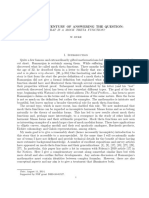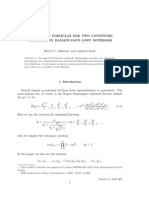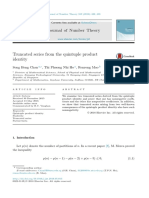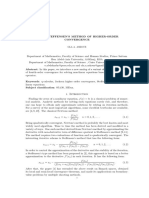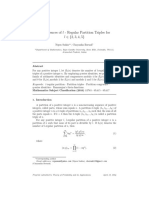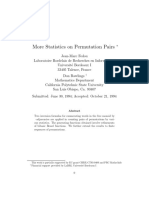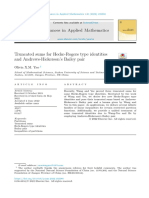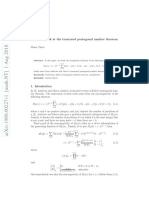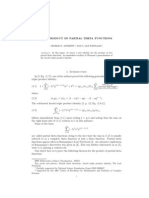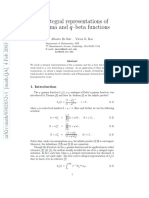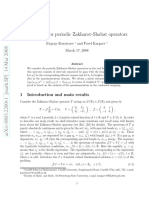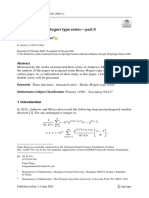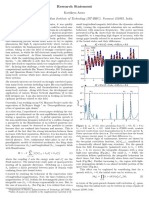The Q-Binomial Theorem and Two Symmetric
The Q-Binomial Theorem and Two Symmetric
Uploaded by
Haroon RashidCopyright:
Available Formats
The Q-Binomial Theorem and Two Symmetric
The Q-Binomial Theorem and Two Symmetric
Uploaded by
Haroon RashidOriginal Title
Copyright
Available Formats
Share this document
Did you find this document useful?
Is this content inappropriate?
Copyright:
Available Formats
The Q-Binomial Theorem and Two Symmetric
The Q-Binomial Theorem and Two Symmetric
Uploaded by
Haroon RashidCopyright:
Available Formats
The q-Binomial Theorem and two Symmetric
q-Identities
Victor J. W. Guo
Center for Combinatorics, LPMC
Nankai University, Tianjin 300071, People’s Republic of China
jwguo@eyou.com
Submitted: Jun 30, 2003; Accepted: Sep 4, 2003; Published: Sep 12, 2003
MR Subject Classifications: 05A19, 05A17
Abstract
We notice two symmetric q-identities, which are special cases of the transfor-
mations of 2 φ1 series in Gasper and Rahman’s book (Basic Hypergeometric Series,
Cambridge University Press, 1990, p. 241). In this paper, we give combinatorial
proofs of these two identities and the q-binomial theorem by using conjugation of
2-modular diagrams.
1 Introduction
We follow the notation and terminology in [7], and we always assume that 0 ≤ |q| < 1.
The q-shifted factorial is defined by
Y
n−1 Y
∞
(a; q)0 = 1, (a; q)n = (1 − aq ), n ∈ N,
k
(a; q)∞ = (1 − aq k ).
k=0 k=0
The following theorem is usually called the q-binomial theorem. It was found by Rothe,
and was rediscovered by Cauchy (see [1, p. 5]).
Theorem 1.1 If |z| < 1, then
X
∞
(a; q)n (az; q)∞
zn = . (1.1)
n=0
(q; q)n (z; q)∞
Various proofs (1.1) are known. For simple proofs of (1.1), see Andrews [3, Section
2.2] and Gasper [6], and for combinatorial proofs, see Alladi [2] and Pak [8].
The following two theorems are special cases of the transformations of 2 φ1 series in
Gasper and Rahman [7, p. 241].
the electronic journal of combinatorics 10 (2003), #R34 1
Theorem 1.2 For |a| < 1 and |b| < 1, we have
X∞
(az; q)n n X (bz; q)n n
∞
b = a . (1.2)
n=0
(a; q) n+1 n=0
(b; q) n+1
Theorem 1.3 We have
X
n
(q/z; q)k (z; q)n−k X
m
(q/z; q)k (z; q)m−k
q z =
mk k
q nk z k . (1.3)
k=0
(q; q)k (q; q)n−k k=0
(q; q)k (q; q)m−k
Clearly, the left-hand side of (1.2) may be written as
1
2 φ1 (az, q; qa; q, b). (1.4)
(1 − a)
By the Heine’s transformation (III.1) in Gasper and Rahman [7, p. 241], (1.4) is equal to
1 (q, abz; q)∞
2 φ1 (a, b; abz; q, q),
(1 − a) (qa, b; q)∞
which is symmetric in a and b. Note that the special case z = 0 of (1.2) has also appeared
in the literature (see Stockhofe [9] and Pak [8, 2.2.4]).
Rewrite the left-hand side of (1.3) as
(z; q)n −n
2 φ1 (q , q/z; q 1−n /z; q, q m+1 ).
(q; q)n
Applying the transformation (III.6) in [7, p. 241], we get
q mn 3 φ2 (q −n , q −m , z; q, 0; q, q),
which is symmetric in m and n.
The purpose of this paper is to give combinatorial proofs of (1.1), (1.2), and (1.3) by
using conjugation of 2-modular diagrams.
As usual, a partition λ is defined as a finite sequence of nonnegative integers (λ1 , λ2 , . . . ,
λm ) in decreasing order λ1 ≥ λ2 ≥ · · · ≥ λm . A nonzero λi is called a part of λ. The
numbers of odd parts and even parts of λ are denoted by odd(λ) and even(λ), Pm respectively.
Define `(λ) = odd(λ) + even(λ), called the length of λ. Write |λ| = i=1 λi , called the
weight of λ.
The set of all partitions into even parts is denoted by Peven . The set of all partitions
into distinct odd parts is denoted by Dodd . Let P1 (respectively, P2 ) denote the set of
partitions with no repeated odd (respectively, even) parts.
For partitions λ and µ, we define λ ∪ µ to be the partition obtained by putting all
parts of λ and µ together in decreasing order.
the electronic journal of combinatorics 10 (2003), #R34 2
2 A Theorem on Partitions
The following theorem is crucial to prove Theorems 1.1–1.3 combinatorially.
Theorem 2.1 Given m ≥ 1, the number of partitions of n into at most m parts with no
repeated odd parts is equal to the number of partitions of n with the largest part at most
2m and with no repeated odd parts.
Theorem 2.1 was established by Chapman [5] in his proof of the q-identity
X∞
−q 2n−1 + q 2n Y 1 − q 2j−1 Y 1 − q 2j−1 X
n−1 ∞ ∞
qd
n = (−1) d
,
n=1
1 − q 2n j=1
1 − q 2j j=1
1 − q 2j d=1 1 − qd
which is due to Andrews, Jiménez-Urroz, and Ono [4]. Here we describe Chapman’s proof.
Proof of Theorem 2.1. We shall construct an involution σ on P1 such that σ preserves |λ|
while interchanging `(λ) and dλ1 /2e.
We construct a diagram for each λ ∈ P1 . Each part λi will yield a row of length
dλi /2e. An even part 2k will give a row of k 2’s, while an odd part 2k + 1 will give a row
of k 2’s followed by a 1. Such a diagram is called a 2-modular diagram. As an example,
let λ = (10, 9, 7, 4, 4, 4, 3, 2, 2, 1). Then, λ gives the 2-modular diagram
2 2 2 2 2
2 2 2 2 1
2 2 2 1
2 2
2 2
2 2
2 1
2
2
1
Since no odd part of λ is repeated, the 1’s can only occur at the bottom of columns.
We identify elements of P1 with their diagrams, and then define σ to be conjugation of
diagrams. For the above λ, σ(λ) gives the 2-modular diagram
2 2 2 2 2 2 2 2 2 1
2 2 2 2 2 2 1
2 2 2
2 2 1
2 1
the electronic journal of combinatorics 10 (2003), #R34 3
Namely, σ(λ) = (19, 13, 6, 5, 3). Clearly, the number of rows in the diagram of λ is
`(λ), while the number of columns is dλ1 /2e. Thus, σ has the required properties and
Theorem 2.1 is proved.
Note that the above involution σ on P1 also preserves odd(λ).
3 Combinatorial Proofs of Theorems 1.1, 1.2, and 1.3
In this section, we give combinatorial proofs of the q-binomial theorem and Theorems 1.2
and 1.3. Our combinatorial proof of the q-binomial theorem is based on Theorem 2.1,
and is essentially the same as that of Alladi [2] or Pak [8].
Proof of Theorem 1.1. Replacing q and a by q 2 and −aq, respectively, (1.3) becomes
X
∞
(−aq; q 2 )n (−aqz; q 2 )∞
zn = . (3.1)
n=0
(q 2 ; q 2)n (z; q 2 )∞
It is easy to see that the coefficient of z n on the left-hand side of (3.1) is equal to
X
q |µ| aodd(µ) ,
µ∈P1
µ1 ≤2n
while the coefficient of z n on the right-hand side is equal to
X
q |µ| aodd(µ) .
µ∈P1
`(µ)≤n
The proof then follows from the involution σ in the proof of Theorem 2.1.
Proof of Theorem 1.2. Replacing q and z by q 2 and −zq, respectively, (1.2) becomes
X
∞
(−azq; q 2 )n X
∞
(−bzq; q 2 )n
b = n
an . (3.2)
n=0
(a; q 2 )n+1 n=0
(b; q 2 )n+1
It is easy to see that the coefficient of am bn on the left-hand side of (3.2) is equal to
X
q |µ| z odd(µ) ,
µ∈P1
`(µ)≤m
µ1 ≤2n
while the coefficient of am bn on the right-hand side is equal to
X
q |µ| z odd(µ) .
µ∈P1
`(µ)≤n
µ1 ≤2m
the electronic journal of combinatorics 10 (2003), #R34 4
By the involution σ in the proof of Theorem 2.1, we have
X X
q |µ| z odd(µ) = q |µ| z odd(µ) . (3.3)
µ∈P1 µ∈P1
`(µ)≤n `(µ)≤m
µ1 ≤2m µ1 ≤2n
This completes the proof.
Replacing q and z by q 2 and −zq, respectively, (1.3) may be written as
X
n
k (−q/z; q )k (−zq; q )n−k (2m+1)k k
2 2
(−1) q z
(q 2 ; q 2 )k (q 2 ; q 2 )n−k
k=0
X
m
k (−q/z; q )k (−zq; q )m−k (2n+1)k k
2 2
= (−1) q z . (3.4)
k=0
(q 2 ; q 2 )k (q 2 ; q 2 )m−k
We will prove (3.4) combinatorially by first establishing the following two lemmas.
Lemma 3.1 For m ≥ 0 and n ≥ 1, we have
X
n
(−q/z; q 2 )k (−zq; q 2 )n−k (2m+1)k k
(−1)k q z
k=0
(q 2 ; q 2 )k (q 2 ; q 2 )n−k
X
= (−1)`(λ) q |λ|+|µ| z odd(λ)+odd(µ) . (3.5)
(λ, µ)∈P2 ×P1
`(λ)+`(µ)≤n
λ`(λ) ≥2m+1
Proof. It is easy to see that
(−q/z; q 2 )k k X X
z = q |λ| z k−`(λ) q |µ|
(q 2 ; q 2 )k µ∈Peven
λ∈Dodd
λ1 ≤2k−1 µ1 ≤2k
X
= q |τ | z k−odd(τ ) ,
τ ∈P1
τ1 ≤2k
where τ = λ ∪ µ.
By the involution σ in the proof of Theorem 2.1, we have
X X
q |τ | z k−odd(τ ) = q |τ | z k−odd(τ ) ,
τ ∈P1 τ ∈P1
τ1 ≤2k `(τ )≤k
the electronic journal of combinatorics 10 (2003), #R34 5
Hence,
(−q/z; q 2 )k (2m+1)k k X
q z = q |τ |+(2m+1)k z k−odd(τ )
(q ; q )k
2 2
τ ∈P 1
`(τ )≤k
X
= q |λ| z k−even(λ)
λ=(λ1 ,...,λk )∈P2
λk ≥2m+1
X
= q |λ| z odd(λ) ,
λ=(λ1 ,...,λk )∈P2
λk ≥2m+1
where λi = τi + 2m + 1 (1 ≤ i ≤ k).
Similarly, we have
(−zq; q 2 )n−k X
= q |µ| z odd(µ) .
(q 2 ; q 2 )n−k µ∈P1
`(µ)≤n−k
Therefore, the left-hand side of (3.5) is equal to
X
n X X
(−1)k q |λ| z odd(λ) q |µ| z odd(µ)
k=0 λ=(λ1 ,...,λk )∈P2 µ∈P1
λk ≥2m+1 `(µ)≤n−k
X
= (−1)`(λ) q |λ|+|µ| z odd(λ)+odd(µ) , (3.6)
(λ, µ)∈P2 ×P1
`(λ)+`(µ)≤n
λ`(λ) ≥2m+1
as desired.
Lemma 3.2 For m ≥ 0 and n ≥ 1, we have
X X
(−1)`(λ) q |λ|+|µ| z odd(λ)+odd(µ) = q |µ| z odd(µ) . (3.7)
(λ, µ)∈P2 ×P1 µ∈P1
`(λ)+`(µ)≤n `(µ)≤n
λ`(λ) ≥2m+1 µ1 ≤2m
Proof. Let
B := {(λ, µ) ∈ P2 × P1 : `(λ) + `(µ) ≤ n and λ`(λ) ≥ 2m + 1}.
We will construct an involution φ on the subset
Bm := {(λ, µ) ∈ B : λ 6= 0 or µ1 ≥ 2m + 1}
the electronic journal of combinatorics 10 (2003), #R34 6
of B, with the properties that φ preserves |λ|+|µ| and odd(λ)+odd(µ) while sign-reversing
(−1)`(λ) .
For any (λ, µ) ∈ Bm , note that no even part of λ is repeated while no odd part of µ
is repeated. Define
(
((µ1 , λ1 , λ2 , . . .), (µ2 , µ3, . . .)), if λ1 < µ1 or λ1 = µ1 = 2s + 1,
φ((λ, µ)) =
((λ2 , λ3 , . . .), (λ1 , µ1 , µ2 , . . .)), if λ1 > µ1 or λ1 = µ1 = 2s.
It is straightforward to verify that φ is an involution on Bm with the required properties.
This proves that X
(−1)`(λ) q |λ|+|µ| z odd(λ)+odd(µ) = 0,
(λ, µ)∈Bm
which implies (3.7).
Proof of Theorem 1.3. Combining Lemmas 3.1 and 3.2, we obtain
X
n
(−q/z; q 2 )k (−zq; q 2 )n−k (2m+1)k k X
(−1)k q z = q |µ| z odd(µ) .
(q ; q )k (q ; q )n−k
2 2 2 2
µ∈P
k=0 1
`(µ)≤n
µ1 ≤2m
By symmetry, we have
Xm
(−q/z; q 2 )k (−zq; q 2 )m−k (2n+1)k k X
(−1)k 2 ; q 2 ) (q 2 ; q 2 )
q z = q |µ| z odd(µ) .
k=0
(q k m−k µ∈P 1
`(µ)≤m
µ1 ≤2n
The proof then follows from (3.3).
Acknowledgments. This work was done under the auspices of the National “973”
Project on Mathematical Mechanization, and the National Science Foundation of China.
The author would like to thank the referee for valuable comments.
References
[1] C. Adiga, B. C. Berndt, S. Bhargava, and G. N. Watson, Chapter 16 of Ramanujan’s
second notebook: theta-functions and q-series, Mem. Amer. Math. Soc., 53 (1985),
v+85 pp.
[2] K. Alladi, A fundamental invariant in the theory of partitions, In: Topics in Number
Theory (University Park, PA, 1997), Kluwer Academic Publishers, Dordrecht, 1999,
pp. 101–113.
[3] G. E. Andrews, The Theory of Partitions, Cambridge University Press, Cambridge,
1998.
the electronic journal of combinatorics 10 (2003), #R34 7
[4] G. E. Andrews, J. Jiménez-Urroz, and K. Ono, q-series identities and values of certain
L-functions, Duke Math. J., 108 (2001), 395–419.
[5] R. Chapman, Combinatorial proofs of q-series identities, J. Combin. Theory Ser. A,
99 (2002), 1–16.
[6] G. Gasper, Elementary derivations of summation and transformation formulas for
q-series, In: Special Functions, q-Series and Related Topics (Toronto, ON, 1995),
55–70, Fields Inst. Commun., 14, Amer. Math. Soc., Providence, RI, 1997.
[7] G. Gasper and M. Rahman, Basic Hypergeometric Series, Encyclopedia of Mathe-
matics and its Applications, Vol. 35, Cambridge University Press, Cambridge, 1990.
[8] I. Pak, Partition bijections, a survey, Ramanujan J., to appear.
[9] D. Stockhofe, Bijektive Abbildungen auf der Menge der Partitionen einer natürlichen
Zahl, Bayreuth. Math. Schr. No. 10, (1982), 1–59.
the electronic journal of combinatorics 10 (2003), #R34 8
You might also like
- Mock ThetaDocument10 pagesMock ThetaRina VarmaNo ratings yet
- Study On The Volumetric Behavior of Base Oils, Brines, and Drilling Fluids Under Extreme Temperatures and PressuresDocument11 pagesStudy On The Volumetric Behavior of Base Oils, Brines, and Drilling Fluids Under Extreme Temperatures and PressuresGabriel VargasNo ratings yet
- Interlacing and Bounds of Zeros of Quasi-Orthogonal Little Q-Jacobi PolynomialsDocument14 pagesInterlacing and Bounds of Zeros of Quasi-Orthogonal Little Q-Jacobi Polynomialspranaygoswami1983No ratings yet
- Asymptotic Formulas For Two Continued Fractions in Ramanujan's Lost NotebookDocument17 pagesAsymptotic Formulas For Two Continued Fractions in Ramanujan's Lost Notebookapi-26401608No ratings yet
- 10.1216@RMJ 2017 47 8 2723Document8 pages10.1216@RMJ 2017 47 8 2723Mircea MercaNo ratings yet
- Xia-Zhao2021 Article TruncatedSumsForThePartitionFuDocument8 pagesXia-Zhao2021 Article TruncatedSumsForThePartitionFuDan DanielNo ratings yet
- Quadratic Iterations To Π Associated With Elliptic Functions To The Cubic And Septic BaseDocument16 pagesQuadratic Iterations To Π Associated With Elliptic Functions To The Cubic And Septic BaseRenee BravoNo ratings yet
- Shanks 4Document8 pagesShanks 4Dan DanielNo ratings yet
- The C Wp-Bailey ChainDocument16 pagesThe C Wp-Bailey ChainNo FaceNo ratings yet
- 1 s2.0 S0022314X16301299 MainDocument19 pages1 s2.0 S0022314X16301299 MainMircea MercaNo ratings yet
- Ramanujan 1psi1Document5 pagesRamanujan 1psi1michael pasquiNo ratings yet
- 10 31801-Cfsuasmas 1009068-2024592Document10 pages10 31801-Cfsuasmas 1009068-2024592Haroon RashidNo ratings yet
- 1 Diagonal coinvariants.: 1 1 n n i i n S + n n S + n n λ λ n i,j i j n i,j n n,c c n,c n n 2 n nDocument3 pages1 Diagonal coinvariants.: 1 1 n n i i n S + n n S + n n λ λ n i,j i j n i,j n n,c c n,c n n 2 n nmqtrinhNo ratings yet
- Basic Steffensen's Method of Higher-Order ConvergenceDocument8 pagesBasic Steffensen's Method of Higher-Order ConvergenceIJAERS JOURNALNo ratings yet
- 1 s2.0 S0097316514001368 MainDocument14 pages1 s2.0 S0097316514001368 MainMircea MercaNo ratings yet
- KJM 47 1-11Document12 pagesKJM 47 1-11bestNo ratings yet
- Pmath940-W2 Copy 7Document11 pagesPmath940-W2 Copy 7Annie LiNo ratings yet
- Chan H H, Chan S H, Liu Z G - Domb's Numbers and Ramanujan-Sato Type Series For Inv (Pi)Document13 pagesChan H H, Chan S H, Liu Z G - Domb's Numbers and Ramanujan-Sato Type Series For Inv (Pi)Renee BravoNo ratings yet
- Representations of Quantum Algebras and Q-Special FunctionsDocument21 pagesRepresentations of Quantum Algebras and Q-Special FunctionsbbteenagerNo ratings yet
- PPNCKHDocument12 pagesPPNCKHtamvothitam4No ratings yet
- Problem Set IDocument4 pagesProblem Set IRUDRA KHANRANo ratings yet
- 1048516534Document50 pages1048516534cinba2000No ratings yet
- 1191-PDF File-1270-1-10-20120117Document18 pages1191-PDF File-1270-1-10-20120117bwzfacgbdjapqbpuywNo ratings yet
- A Note On The Value of Bernoulli Polynomials at Rational NumbersDocument3 pagesA Note On The Value of Bernoulli Polynomials at Rational NumberslgallindoNo ratings yet
- 9 absolutely continuous spectrumDocument7 pages9 absolutely continuous spectrumfanboyamailboxNo ratings yet
- 1 s2.0 S0196885821001482 MainDocument42 pages1 s2.0 S0196885821001482 MainDan DanielNo ratings yet
- 1 s2.0 S0196885822000720 MainDocument28 pages1 s2.0 S0196885822000720 MainDan DanielNo ratings yet
- A Further Look at The Truncated Pentagonal Number TheoremDocument6 pagesA Further Look at The Truncated Pentagonal Number TheoremDan DanielNo ratings yet
- Mathematical Foundations of Computer Science Lecture OutlineDocument5 pagesMathematical Foundations of Computer Science Lecture OutlineChenyang FangNo ratings yet
- Yeujc D 14 00471Document19 pagesYeujc D 14 00471Dan DanielNo ratings yet
- KJM - Volume 9 - Issue 2 - Pages 288-299Document12 pagesKJM - Volume 9 - Issue 2 - Pages 288-299Theepa Gayathri SanthoshNo ratings yet
- The Product of Partial Theta Functions. Accepted, Adv. ApplDocument5 pagesThe Product of Partial Theta Functions. Accepted, Adv. Applapi-26401608No ratings yet
- 1 s2.0 S0195669821001645 MainDocument23 pages1 s2.0 S0195669821001645 MainDan DanielNo ratings yet
- Moments of Escape Times of Random WalkDocument4 pagesMoments of Escape Times of Random Walkinsightstudios33No ratings yet
- Harmonic Functions Are Real Analytic: Verso 03.april.2008Document2 pagesHarmonic Functions Are Real Analytic: Verso 03.april.2008Giggio90No ratings yet
- Solutions To The 78th William Lowell Putnam Mathematical Competition Saturday, December 2, 2017Document9 pagesSolutions To The 78th William Lowell Putnam Mathematical Competition Saturday, December 2, 2017ahmet çolakNo ratings yet
- An Elliptic Curve Test For Mersenne Primes: Benedicth. GrossDocument6 pagesAn Elliptic Curve Test For Mersenne Primes: Benedicth. GrossuimtiazNo ratings yet
- BarrDocument15 pagesBarrYash MehrotraNo ratings yet
- The Schrodinger Equations Generated by Q-Bessel OpDocument8 pagesThe Schrodinger Equations Generated by Q-Bessel OpIrfan AliNo ratings yet
- On Integral Representations of Q - Gamma and Q-Beta FunctionsDocument16 pagesOn Integral Representations of Q - Gamma and Q-Beta Functionsyip90No ratings yet
- 10 1016@j Aim 2020 107051Document19 pages10 1016@j Aim 2020 107051Mircea MercaNo ratings yet
- Estimates For Periodic Zakharov-Shabat Operators 2Document16 pagesEstimates For Periodic Zakharov-Shabat Operators 2yehezkel parraNo ratings yet
- Modulo 2 Congruences For Partitions With Initial RDocument16 pagesModulo 2 Congruences For Partitions With Initial RJames MlotshwaNo ratings yet
- SF2521NPDE hmwk1-2Document5 pagesSF2521NPDE hmwk1-2BlooD LOVERNo ratings yet
- Roychowdhury 2010 MSCDocument16 pagesRoychowdhury 2010 MSCJohnNo ratings yet
- 12713-PDF File-50535-1-10-20240719Document13 pages12713-PDF File-50535-1-10-20240719floyojbzrpmsoggnvjNo ratings yet
- Wang-Yee2021 Article TruncatedHeckeRogersTypeSeriesDocument12 pagesWang-Yee2021 Article TruncatedHeckeRogersTypeSeriesDan DanielNo ratings yet
- Large Minimal Covers Of: Aiden A. Bruen Keldon DrudgeDocument6 pagesLarge Minimal Covers Of: Aiden A. Bruen Keldon DrudgeGhazwan Nabeel Al-EhealyNo ratings yet
- On The Tower Factorization of Integers (Jean-Marie de Koninck William Verreault) (Jeanmariedekoninck - Mat.ulaval - Ca)Document8 pagesOn The Tower Factorization of Integers (Jean-Marie de Koninck William Verreault) (Jeanmariedekoninck - Mat.ulaval - Ca)arnoldo3551No ratings yet
- Enumerative Combinatorics and Posets: Assignment # 2: Felipe Bedoya May 4, 2020Document10 pagesEnumerative Combinatorics and Posets: Assignment # 2: Felipe Bedoya May 4, 2020FelipeNo ratings yet
- ExponDocument9 pagesExponSimos SoldatosNo ratings yet
- RandomDocument6 pagesRandomTytus MetryckiNo ratings yet
- Simpson-Mercer (File 1) (13, June)Document16 pagesSimpson-Mercer (File 1) (13, June)Qurat Ul Ain TariqNo ratings yet
- Convexity Sec ProjDocument13 pagesConvexity Sec Projjipob11905No ratings yet
- Quaternion_algebraDocument5 pagesQuaternion_algebrajurinlbNo ratings yet
- MD 23Document14 pagesMD 23Monsieur LNo ratings yet
- Random Walk/Diffusion: 2.1 Langevin EquationDocument12 pagesRandom Walk/Diffusion: 2.1 Langevin EquationFredy OrjuelaNo ratings yet
- Incomplete Elliptic Integrals in Ramanujan's Lost NotebookDocument46 pagesIncomplete Elliptic Integrals in Ramanujan's Lost Notebookapi-26401608No ratings yet
- 10.3934 dcds.2024075Document25 pages10.3934 dcds.2024075LionNo ratings yet
- On The Irrationality of ZDocument7 pagesOn The Irrationality of ZMeriam LondonNo ratings yet
- Green's Function Estimates for Lattice Schrödinger Operators and ApplicationsFrom EverandGreen's Function Estimates for Lattice Schrödinger Operators and ApplicationsNo ratings yet
- Tytan 2 Led BasicDocument4 pagesTytan 2 Led Basicdriouch MaryemNo ratings yet
- WSS M99P32 D1Document6 pagesWSS M99P32 D1jose luisNo ratings yet
- CIRED 2 - MatheusDocument4 pagesCIRED 2 - MatheusEstácio Tavares Wanderley NetoNo ratings yet
- The Structure of Nickel Dimethylglyoxime : Chs - C N / N C - C H SDocument9 pagesThe Structure of Nickel Dimethylglyoxime : Chs - C N / N C - C H SIsye RahmaenaNo ratings yet
- Transformer Soak Pit DesignDocument2 pagesTransformer Soak Pit DesignPramod B.Wankhade90% (10)
- Quiz 1Document4 pagesQuiz 1maang alleijaNo ratings yet
- Paper - 2 (Question Paper) - 6Document16 pagesPaper - 2 (Question Paper) - 6Saumya MundraNo ratings yet
- Structure Design Code - Structural Design SpecsDocument9 pagesStructure Design Code - Structural Design SpecsNowsherwan MazariNo ratings yet
- Lldpe FN810 (Octeno Sin Slip)Document2 pagesLldpe FN810 (Octeno Sin Slip)Hữu LộcNo ratings yet
- Is 12615-2004Document12 pagesIs 12615-2004Srikanth ReddyNo ratings yet
- Research StatementDocument3 pagesResearch StatementKartikeya aroraNo ratings yet
- Engineering Physics Lab Manual 2023-24Document38 pagesEngineering Physics Lab Manual 2023-24HarriNo ratings yet
- Production Technology Practical FileDocument16 pagesProduction Technology Practical File032AkritiNo ratings yet
- Fluid Mechanics Tutorial No.8A Water Turbines: Dr. Owino George. PH.DDocument19 pagesFluid Mechanics Tutorial No.8A Water Turbines: Dr. Owino George. PH.DGeorge OparNo ratings yet
- R&P Mod 1Document55 pagesR&P Mod 1AmalNo ratings yet
- Surface EnergyDocument5 pagesSurface Energyanon_820770985No ratings yet
- A NIR Technique For Rapid Determination of Soil Mineral NitrogenDocument18 pagesA NIR Technique For Rapid Determination of Soil Mineral NitrogenRattanyoo ApichonpongsakornNo ratings yet
- Installation Manual CSI-1.5K-3K-TL V2.0Document70 pagesInstallation Manual CSI-1.5K-3K-TL V2.0robsondrogalNo ratings yet
- JD Transmision Funk PDFDocument5 pagesJD Transmision Funk PDFrolex21No ratings yet
- 18 Matdip 311Document2 pages18 Matdip 311balajiNo ratings yet
- 2023-24 - SR - Super60 (Incoming) - STERLING - Batch - PHYSICS - Teaching & Test Schedule - Code@03-04-2023Document9 pages2023-24 - SR - Super60 (Incoming) - STERLING - Batch - PHYSICS - Teaching & Test Schedule - Code@03-04-2023Geetha NNo ratings yet
- Nozzle Reinforcement Calculation Excel SheetDocument3 pagesNozzle Reinforcement Calculation Excel Sheetramesh punjabiNo ratings yet
- Phases of The MoonDocument21 pagesPhases of The MoonJacquiline TanNo ratings yet
- Energy-ChangesDocument9 pagesEnergy-ChangesAmalia Dalila MatsimbeNo ratings yet
- Astm A333 A333m 16Document4 pagesAstm A333 A333m 16mrwolveringNo ratings yet
- HERTZ HCP Tech Sheet HCP 4 Rev16aDocument2 pagesHERTZ HCP Tech Sheet HCP 4 Rev16aMauricio Da Cunha AlmeidaNo ratings yet
- Phase Diagram of Carbon Steel PDFDocument6 pagesPhase Diagram of Carbon Steel PDFAnonymous yshOO0tEjKNo ratings yet
- The Nature of Naturally Fractured Reservoirs: Oilfield Review June 2006Document21 pagesThe Nature of Naturally Fractured Reservoirs: Oilfield Review June 2006Oscar Javier ArevaloNo ratings yet
- Edexcel International GCSE Physics Chapter 13 Sound Learning PlanDocument2 pagesEdexcel International GCSE Physics Chapter 13 Sound Learning Planning biNo ratings yet
